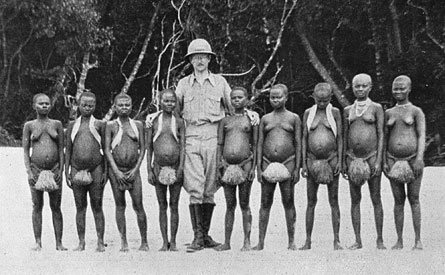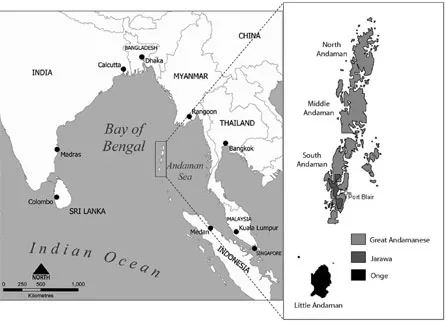Pygmies’ short stature linked to high death rates
Controversial findings suggest that elevated mortality rates breed small bodies
The Grim Reaper can cut life short and, under the right circumstances, whittle those still standing down to the size of pygmies. That’s the controversial conclusion of a new study, published in the October Current Anthropology, that found that stature declined as death rates rose in three small-bodied populations over a 115-year period.


“We provide the first evidence that pygmy body sizes vary considerably over time, that they correlate strongly with mortality rates and that increasing mortality rates lead to even greater reductions of body size,” says Jay Stock of the University of Cambridge in England.
Stock and Andrea Migliano, both anthropologists at the University of Cambridge, say that their findings support a scenario in which most females are able to reproduce at relatively young ages, probably in response to high mortality rates, This physical trait then becomes more common from one generation to the next. Early-maturing bodies divert physiological resources away from growth, yielding small bodies as a side effect, the researchers hypothesize.
Critics of this argument suspect that environmental challenges, such as nutritional deficiencies or cramped forest quarters, prompted the evolution of short-statured populations.
Researchers have traditionally defined pygmies as populations with an average adult male height of no more than 155 centimeters, or about 5 feet, 1 inch. Hunter-gatherer groups classified as pygmies live in various regions, including Africa, Indonesia, the Philippines and the Andaman Islands, which lie southeast of Burma.
Stock and Migliano analyzed data from 11 British government and anthropological studies of Andaman Islanders conducted between 1871 and 1986. Investigations included a range of health and physical measures for 604 individuals from three pygmy groups — the Great Andamanese, the Onge and the Jarawa. Data also included population approximations for each group across time.
Despite describing a small number of people who may have been assessed with varying degrees of accuracy, these studies provide the only long-term glimpse of growth changes within different pygmy groups, Stock says.
British colonies were first established on the Andaman Islands in 1858 and remained until 1947. Onge and Jarawa pygmies, who lived on separate islands, retreated into forests to avoid the British. Great Andamanese pygmies befriended the newcomers.
As a result, Great Andamanese individuals were exposed to infectious diseases against which they had no defense, including influenza, tuberculosis, measles and syphilis. Their approximate numbers dropped from 6,000 in 1858 to 600 in 1900. A low of 19 Great Andamanese individuals was recorded during the 1960s, but the population survives.
British historical records show that average heights for the Great Andamanese dropped markedly during the period of increased mortality, Stock and Migliano say. From 1879 to 1927, the average height of men who were measured decreased at a rate equivalent to 4.7 centimeters, or nearly 2 inches, every 100 years. Measured height declines for women were equivalent to 1.8 centimeters, or almost three-quarters of an inch, every 100 years.
Data from the 19th century were unavailable for the other two pygmy groups that avoided the British. But Onge men and women displayed average height increases from 1927 to 1962, after British attempts to interact with them had stopped. Onge population numbers declined from 1901 to 1951, although not as steeply as among the Great Andamanese.
Jarawa individuals were first measured in 1985. Average heights of 155 centimeters for men and 147 centimeters, or about 4 feet, 10 inches, for women exceeded all average heights recorded for the other two pygmy groups.
Population estimates for the Jarawa held stable during the colonial period, the researchers say.
A related 2007 study led by Migliano reported that pygmies in Africa and the Philippines tend to stop growing by early adolescence, have low life expectancies and begin reproducing at younger ages than taller hunter-gatherers. That pattern of findings also fits the idea that pygmy-sized bodies occur as a by-product of an evolved tendency for women to become fertile early in life, Stock says.
Anthropologist Brian Shea of Northwestern University calls such evidence “interesting but irrelevant to the origin of small body size in human pygmy groups.” Stock and Migliano document short-term, environmentally induced changes in height that would affect the size of any population, Shea contends. This process can’t explain the origin of pygmies, he says.
He and a colleague have measured differing limb proportions in East African and West African pygmies. Other researchers have found slowed growth during childhood for Africa’s Mbuti pygmies, apparently due to reduced levels of a key growth hormone. Such data suggest that these groups have evolved small bodies in direct response to as yet unidentified, long-term challenges in distinctive habitats, Shea says.
Despite past high mortality rates, Stock and Migliano have no solid evidence that any Andaman Island pygmies mature exceptionally fast, remarks anthropologist Barry Bogin of Loughborough University in England. Historical accounts indicate that Andaman Island females married at ages as young as 11, but those sources don’t Indicate whether the girls were sexually mature at marriage, Bogin notes.
Stock and Migliano found no evidence of malnutrition, but they can’t rule out that that a lack of one or more essential nutrients in the diets of Andaman Island pygmies impeded growth, he adds.
“Longitudinal studies of pygmies and other short-statured people, with detailed nutritional and health information, are the only way to study this issue,” Bogin says.







